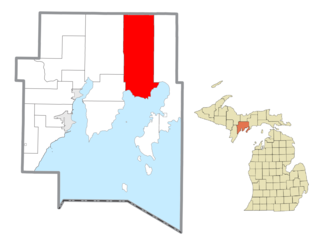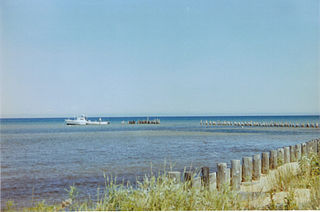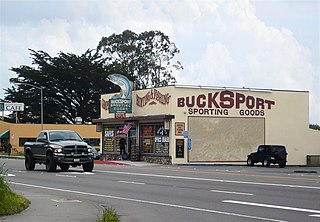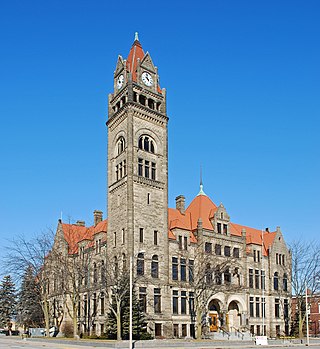
Lumber is wood that has been processed into uniform and useful sizes, including beams and planks or boards. Lumber is mainly used for construction framing, as well as finishing. Lumber has many uses beyond home building. Lumber is sometimes referred to as timber in England, Australia and New Zealand, while in most parts of the world the term timber refers specifically to unprocessed wood fiber, such as cut logs or standing trees that have yet to be cut.

Nahma Township is a civil township of Delta County in the U.S. state of Michigan. The population was 495 at the 2010 census, slightly down from 499 at the 2000 census. Nahma was established in 1881 by the Bay De Noquet Lumber Company as the base for its upper Michigan lumbering operations.

Little Bay de Noc is a bay in the Upper Peninsula of the U.S. state of Michigan. The bay opens into Lake Michigan's Green Bay.

Ephraim Shay was an American merchant, entrepreneur and self-taught railroad engineer who worked in the state of Michigan. He designed the first Shay locomotive and patented the type. He licensed it for manufacture through what became known as Lima Locomotive Works in Ohio; from 1882 to 1892 some 300 locomotives of this type were sold.

A wood waste burner, known as a teepee burner or wigwam burner in the United States and a beehive burner in Canada, is a free-standing conical steel structure usually ranging from 30 to 60 feet in height. They are named for their resemblance to beehives, teepees or wigwams. A sawdust burner is cylindrical. They have an opening at the top that is covered with a steel grill or mesh to keep sparks and glowing embers from escaping. Sawdust and wood scraps are delivered to an opening near the top of the cone by means of a conveyor belt or Archimedes' screw, where they fall onto the fire near the center of the structure.
Pequaming is an unincorporated community in L'Anse Township of Baraga County in the U.S. state of Michigan. It is located on a narrow point of land that juts into Keweenaw Bay. Although still partially inhabited, Pequaming is one of the largest ghost towns in the Upper Peninsula of Michigan.

Samoa is a census-designated place in Humboldt County, California. It is located 1.5 miles (2.4 km) northwest of Eureka, at an elevation of 23 feet. Samoa is located in the northern peninsula of Humboldt Bay and is the site of the Samoa Cookhouse, one of the last remaining original, lumber-camp style cookhouses. The name Samoa is used interchangeably with the peninsula it occupies. The population was 258 at the 2010 census.

The Old Lock Pump House on the Chesapeake & Delaware Canal was one of the first National Historic Landmarks to recognize an engineering achievement rather than an important building or a place associated with an historic event. The pump house, whose first element was built in 1837, preserves a feature of the old canal, which relied on locks and pumps to move vessels over the low divide of the Delmarva Peninsula between Chesapeake Bay and Delaware Bay. Because there are no large rivers on the peninsula, water had to be pumped uphill to fill the upper canal and locks. When the canal was cut deeper in the twentieth century, such measures were no longer required, and the pump house is one of the last relics of the old canal.

Shelldrake is a ghost town in Whitefish Township, Chippewa County, Michigan, United States, about 8 miles (13 km) south of Whitefish Point, Michigan at the mouth of the Shelldrake River on Whitefish Bay. It is listed on the Michigan Historic Register. Prior to European settlement it supported a seasonal Native American fishing village. In the 1890s and early 1900s, it was a thriving sawmill town during peak logging years on the Tahquamenon River watershed. By the 1920s repeated fires and the decline of lumbering led to its demise. Today it is a privately owned ghost town with only a few weathered, original buildings.

Bucksport was a town in Humboldt County, California. The original location was 2.5 miles (4 km) southwest of downtown Eureka, on Humboldt Bay about 5 miles (8 km) northeast of entrance. at an elevation of 16 feet (4.9 m). Prior to American settlement a Wiyot village named Kucuwalik stood here.

Big Bay de Noc is a bay in the Upper Peninsula of the U.S. state of Michigan. The bay, which opens into Lake Michigan's Green Bay, is enclosed by Delta County. The Garden Peninsula is on the east side of the bay and the Stonington Peninsula is on the west side. The small Delta County settlements of Garden and Nahma are harbors on the shore of the bay.

The Calumet and Hecla Industrial District is a historic district located in Calumet, Michigan and roughly bounded by Hecla & Torch Lake Railroad tracks, Calumet Avenue, Mine and Depot Streets. The district contains structures associated with the copper mines worked by the Calumet and Hecla Mining Company, located along a line above the copper lode, where railroad tracks connected separate mine heads. The Historic District is completely contained in the Calumet Historic District and the Keweenaw National Historical Park. It was designated a Michigan State Historic Site in 1973 and was listed on the National Register of Historic Places in 1974.

The Nahma and Northern Railway Locomotive #5 is a locomotive located at the corner of Main Street and River Street in Nahma Township, Michigan.

Alvin Clark was a schooner that sailed the Great Lakes for almost two decades. Constructed in 1846 or 1847, it sank during a storm in Green Bay in 1864. It was salvaged in 1969 and moored in Menominee, Michigan, at the Mystery Ship Seaport, located in the Menominee River at the foot of Sixth Avenue. The ship was designated a Michigan State Historic Site in 1972 and listed on the National Register of Historic Places in 1974; Alvin Clark was removed from the National Register of Historic Places on June 10, 2020. Although the schooner was in pristine condition when raised, no plans were in place for its conservation, and the ship rapidly deteriorated. The remains of Alvin Clark were destroyed in 1994.

Spider Cave, also known as Burnt Bluff Cave or 20DE3, is an archaeological site located on the Garden Peninsula near Fayette, Michigan. It was listed on the National Register of Historic Places in 1971.

The Cobbs and Mitchell Building is an office building located at 100 East Chapin Street in Cadillac, Michigan. It was designated a Michigan State Historic Site in 1980. and listed on the National Register of Historic Places in 2010.

The Charles Mears Silver Lake Boardinghouse is a boardinghouse located at the outlet of Silver Lake, near Mears, Michigan. It is one of the few remaining structures built to serve the lumbering industry, which was Michigan's predominant industry in the 19th century. It was designated a Michigan State Historic Site and listed on the National Register of Historic Places in 1986.

Grand Mound Town Hall and Waterworks Historic District, also known as Hose house, pump house, is a historic district located in Grand Mound, Iowa, United States. It was listed on the National Register of Historic Places in 2001. The district is composed of two buildings and the town's water tower.

The Bay City Hall is a government building located at 301 Washington Street in Bay City, Michigan. It was listed on the National Register of Historic Places in 1975.

Millview is an unincorporated community located along Perdido Bay in Escambia County, Florida, United States.






















